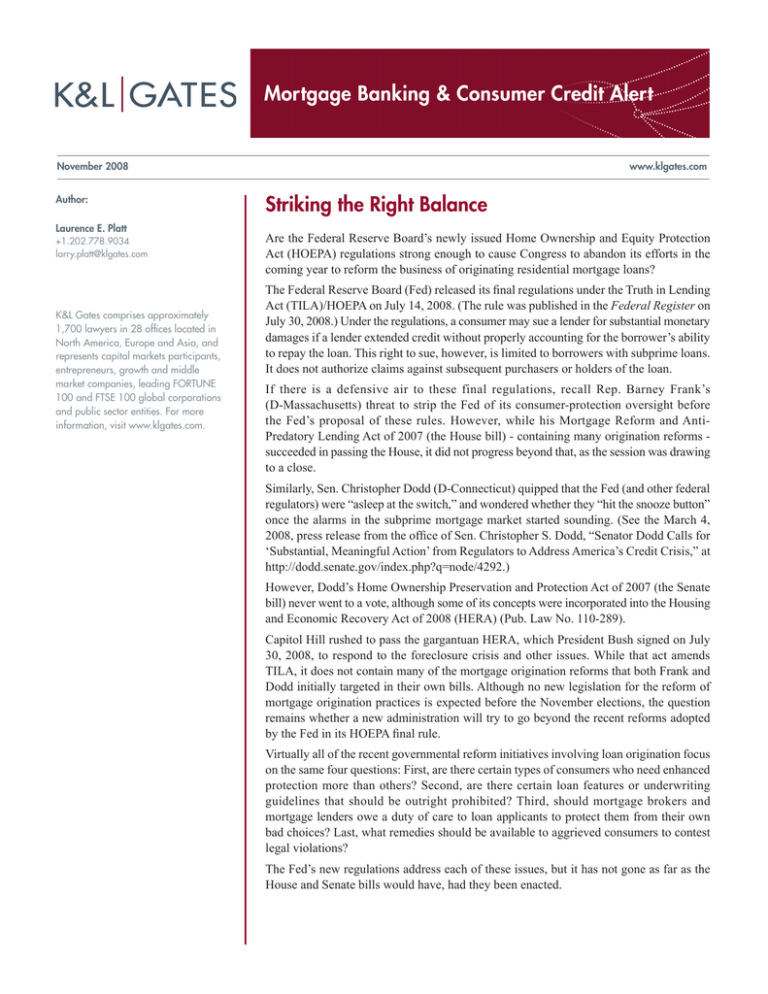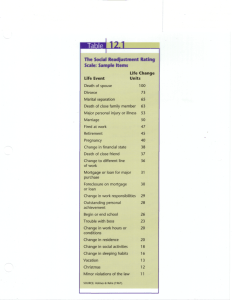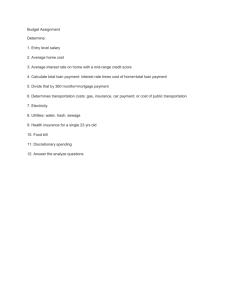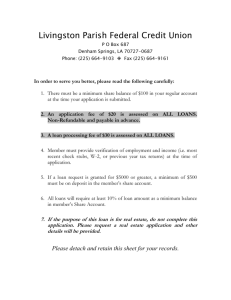
Mortgage Banking & Consumer Credit Alert
November 2008
Author:
Laurence E. Platt
+1.202.778.9034
larry.platt@klgates.com
K&L Gates comprises approximately
1,700 lawyers in 28 offices located in
North America, Europe and Asia, and
represents capital markets participants,
entrepreneurs, growth and middle
market companies, leading FORTUNE
100 and FTSE 100 global corporations
and public sector entities. For more
information, visit www.klgates.com.
www.klgates.com
Striking the Right Balance
Are the Federal Reserve Board’s newly issued Home Ownership and Equity Protection
Act (HOEPA) regulations strong enough to cause Congress to abandon its efforts in the
coming year to reform the business of originating residential mortgage loans?
The Federal Reserve Board (Fed) released its final regulations under the Truth in Lending
Act (TILA)/HOEPA on July 14, 2008. (The rule was published in the Federal Register on
July 30, 2008.) Under the regulations, a consumer may sue a lender for substantial monetary
damages if a lender extended credit without properly accounting for the borrower’s ability
to repay the loan. This right to sue, however, is limited to borrowers with subprime loans.
It does not authorize claims against subsequent purchasers or holders of the loan.
If there is a defensive air to these final regulations, recall Rep. Barney Frank’s
(D-Massachusetts) threat to strip the Fed of its consumer-protection oversight before
the Fed’s proposal of these rules. However, while his Mortgage Reform and AntiPredatory Lending Act of 2007 (the House bill) - containing many origination reforms succeeded in passing the House, it did not progress beyond that, as the session was drawing
to a close.
Similarly, Sen. Christopher Dodd (D-Connecticut) quipped that the Fed (and other federal
regulators) were “asleep at the switch,” and wondered whether they “hit the snooze button”
once the alarms in the subprime mortgage market started sounding. (See the March 4,
2008, press release from the office of Sen. Christopher S. Dodd, “Senator Dodd Calls for
‘Substantial, Meaningful Action’ from Regulators to Address America’s Credit Crisis,” at
http://dodd.senate.gov/index.php?q=node/4292.)
However, Dodd’s Home Ownership Preservation and Protection Act of 2007 (the Senate
bill) never went to a vote, although some of its concepts were incorporated into the Housing
and Economic Recovery Act of 2008 (HERA) (Pub. Law No. 110-289).
Capitol Hill rushed to pass the gargantuan HERA, which President Bush signed on July
30, 2008, to respond to the foreclosure crisis and other issues. While that act amends
TILA, it does not contain many of the mortgage origination reforms that both Frank and
Dodd initially targeted in their own bills. Although no new legislation for the reform of
mortgage origination practices is expected before the November elections, the question
remains whether a new administration will try to go beyond the recent reforms adopted
by the Fed in its HOEPA final rule.
Virtually all of the recent governmental reform initiatives involving loan origination focus
on the same four questions: First, are there certain types of consumers who need enhanced
protection more than others? Second, are there certain loan features or underwriting
guidelines that should be outright prohibited? Third, should mortgage brokers and
mortgage lenders owe a duty of care to loan applicants to protect them from their own
bad choices? Last, what remedies should be available to aggrieved consumers to contest
legal violations?
The Fed’s new regulations address each of these issues, but it has not gone as far as the
House and Senate bills would have, had they been enacted.
Mortgage Banking & Consumer Credit Alert
Summary of HOEPA regulations
Defining them as “higher-priced mortgage loans,”
the Fed created a new class of closed-end, owneroccupied, subprime residential mortgage loans that
fall between “high-cost” loans under HOEPA and
“prime” loans. The final regulation provides one set
of new requirements that apply only to these higherpriced mortgage loans, another set that apply to most
closed-end residential mortgage loans secured by the
consumer’s principal dwelling, and a last category that
apply to virtually all residential mortgage loans.
Prohibiting a lender from making a loan without regard
to a borrower’s ability to repay the loan from verified
income and assets other than the home’s value is the
hallmark of the new restrictions for higher-priced
mortgage loans.
In addition, those higher-priced loans must not include
prepayment penalties if the payment can change
during the loan’s first four years, and in all other cases
a prepayment penalty period must not last for more
than two years and may not be imposed on a “samecreditor refinance.”
A lender must establish an escrow account for the
payment of property taxes and homeowners’ insurance
for first-lien, higher-priced loans, although it may offer
the borrower the opportunity to cancel the escrow
account after one year.
All closed-end mortgages secured by a consumer’s
principal dwelling are subject to certain servicing
requirements. A loan servicer may not: fail to credit
a payment to a consumer’s account as of the date the
payment is received; fail to provide a payoff statement
within a reasonable period of time; or “pyramid”
late fees.
In addition, a creditor or broker of principal-dwelling
loans is prohibited from coercing or encouraging
an appraiser to misrepresent the value of a home. A
creditor is also prohibited from extending credit based
on an appraisal if the creditor knows, at or before
loan consummation, of any prohibited coercion or
encouragement in connection with that appraisal
(unless the creditor can show that the appraisal
does not materially misstate or misrepresent the
dwelling’s value).
Last, creditors must provide a Good Faith Estimate of
the loan costs, including a schedule of payments, within
three days after a consumer applies for any principal-
dwelling loan, which includes home-improvement
loans and loans to refinance existing loans. Advertising
for virtually all residential mortgage loans must contain
additional information about rates, monthly payments
and other loan features, and is subject to a ban on
seven deceptive or misleading practices, including
representing that a rate or payment is “fixed” when it
can change.
Enhanced protection based on the cost
of the loan
Market rejection of high-cost loans
In 1994, Congress amended TILA by enacting
HOEPA to impose a new federal regulatory regime
for high-cost loans. The law relies on a quantitative
threshold to determine its applicability. One test is
based on the yield of Treasury securities calculated
on the annual percentage rate of the loan, which is
a formula long used for disclosure purposes under
TILA and is designed to depict the all-in cost of a loan.
The other test is the total points and fees charged to
the borrower. Loans that exceed either threshold are
subject to HOEPA.
Underlying HOEPA was a public policy premise that
consumers who pay materially more for a residential
mortgage loan than market prices for prime loans
probably need greater protection than mere disclosures
could provide.
Whether it is a brutal need for credit that blinds
the borrower to disclosed risks or unsophisticated
borrowers who simply cannot understand the contents
of the disclosures, the result is the same. Lenders
are required to protect at-risk borrowers from their
perceived inability to make prudent loan choices. And
the borrower may raise any claim or defense against the
ultimate holder that it may raise against the originating
lender - the so-called assignee liability.
Not many in the industry worry about the scope of
HOEPA’s prohibitions because precious few will make,
buy, finance or securitize high-cost loans. Some of
the provisions are inherently subjective so that even a
lender acting in good faith cannot tell whether it has
complied with the law.
Moreover, the remedies available to a borrower under
HOEPA against both the originating lender and any
assignee empower borrowers to reap large economic
windfalls that may bear no rational relationship to
actual harm. Indeed, a loan can evaporate in the hands
November 2008 | 2
Mortgage Banking & Consumer Credit Alert
of the holder regardless of whether the holder knew of
or participated in the origination of the loan. Virtually
no one will risk his or her capital to make or buy
a loan where the potential risks outweigh the
potential return.
Consumer advocates long have claimed that the highcost test for a HOEPA loan was too high to protect
borrowers in need. In state after state, consumer groups
successfully lobbied state legislatures to pass their own
mini-HOEPA statutes.
These local initiatives materially reduced the financial
triggers that determined the classification of a loan
as high-cost and materially expanded the inherently
subjective restrictions on lenders. While the amount
of the reductions differed, the basic approach was the
same. The rationale was that the cost of credit should
determine the scope of the enhanced legal protection;
the more the cost, the greater the protection.
In many cases, the end result was the same as with
HOEPA. Few will make, buy, finance or securitize
high-cost loans under state laws that subject creditors
and assignees to monetary damages bearing no rational
relationship to actual harm based on violations of laws
that are inherently subjective.
Creation of new category for higher-cost loans
Recent federal initiatives reinforce the policy premise
that higher-cost loans should carry greater consumer
protections. Yet if the industry won’t play in the highcost loan market, how can one define a subprime loan
in a way that provides greater protections but still
supports an active market?
The answer is the creation of a new category of loans
based on their cost, where the protections afforded
consumers are less extensive than those provided under
high-cost loans but more than those provided for prime
loans. Just as with “high-cost” loans, the public policy
question is how to define the cost triggers?
The new HOEPA regulations take a simpler approach
to defining a quantitative proxy for subprime loans.
The test does not rely on either the total points and fees
charged on the loan or the yield of Treasury securities.
Instead, the Fed sought a more perfect proxy for the
subprime market.
Defining subprime loans as “higher-priced mortgage
loans,” the Federal Reserve Board will publish the
“average prime offer rate,” based on a survey currently
published by Freddie Mac. A loan is “higher-priced” if
it is a first-lien mortgage and has an annual percentage
rate that is 1.5 percentage points or more above this
index, or 3.5 percentage points if it is a subordinatelien mortgage.
Scope of enhanced protections
After isolating which loans would be subject to the new
requirements, lawmakers must determine what new
requirements would apply to such loans.
One criticism is type of loan product. Although
negatively amortizing, nontraditional mortgages have
been around for years, the loans typically were used
to provide more affluent, self-employed borrowers
with flexibility to make lower monthly payments to
account for irregular income - not as a device to qualify
borrowers for loan amounts for which they might not
otherwise qualify. Similarly, adjustable-rate mortgage
(ARM) loans have been around for more years than
“subprime” has been a word in the dictionary. So why
all the controversy?
Well, payment-option ARMs (where borrowers may
choose the amount of their monthly payments in excess
of a minimum) or interest-only loans (where borrowers
may pay only interest for several years before the loan
begins to amortize and principal must be repaid) offer
consumers the flexibility to manage their cash flows.
Yet those who obtain these loans to qualify for a larger
mortgage than they could otherwise obtain may find it
difficult to grapple with the resulting payment shock.
Refinancing out of a negatively amortizing loan can be
difficult if property values decline and consumer credit
is less available. Like disregarding the calorie and fat
content on a food label, many consumers disregarded
the detailed disclosures of this inherent risk; their
eyes were bigger than their stomachs in their ability to
digest increasing debt payments.
If one-year ARMs have been a staple of the conventional
loan market for so long, why are hybrid 2/28 and 3/27
ARMs regarded with such disfavor? Is it the product
itself, the pricing of the product or the circumstances
of the borrowers who obtain the product?
Generally speaking, the criticism of hybrid ARMs
centers on the size and frequency of the adjustments. If
the initial interest rate is an introductory rate, then there
will be an increase in payments upon the expiration of
the initial fixed term even if interest rates hold steady.
Subsequent adjustments would depend on changes in
the interest rate. The real issue with hybrid ARMs is
the size of any adjustment. If there are caps at all on the
initial and subsequent adjustments, the amount of the
November 2008 | 3
Mortgage Banking & Consumer Credit Alert
cap often is materially higher than one might find with
traditional conventional conforming loan products.
None of the federal or state statutory or regulatory
initiatives seek to ban outright nontraditional mortgages
or hybrid ARMs. Indeed, any such ban by a state might
be federally preempted by the Alternative Mortgage
Transaction Parity Act.
Lawmakers, instead, are focusing on the role such
products play in qualifying a borrower for a mortgage
loan. In other words, the use of these products is more
of an underwriting issue than an issue regarding the
per se propriety of the products.
Failing to determine a borrower’s ability to repay
the loan through relaxed underwriting standards is
the second major area that has drawn deep criticism.
What is the actual amount of the monthly payment that
the borrower must have the ability to repay? Is it the
amount that is due after the loan closes? Or is it the
higher amount that may be due when the introductory
rate expires?
Could it be the highest possible amount if the
payments were to increase at each adjustment period
to the maximum amount? The general public policy
consensus at this point is that underwriting should not
be based solely on a temporary initial payment that is
expected to increase in a material way after closing.
The failure to verify an applicant’s current and
reasonably anticipated future income and financial
assets through reliable, primary, third-party sources is
considered by many to be a leading cause of the current
high default rate among subprime and alternative-A
borrowers. Lenders did not generally rely solely on
the borrowers’ claims about their income. They pulled
credit scores; they evaluated the reasonableness of
the claimed amounts through secondary sources. But,
depending on the loan product, lenders did not always
use the old-fashioned way of laboriously verifying the
borrower’s income and assets.
Establishing the proper debt-to-income (DTI) ratio is
the third element of the underwriting issue. How much
of one’s income should be permitted to be used for
monthly housing debt, and what should the relationship
between DTI ratios and available liquid assets be?
How much income should be left over to pay for
other items, such as food, health care, credit cards and
unanticipated expenses?
Investors and insurers have established such guidelines
for years, although they typically provide for variances
based on compensating factors. Moreover, geographic
areas with substantially higher housing prices generally
require higher DTI ratios; the percentage of one’s
income used to pay for monthly housing expenses
generally is much higher in Los Angeles than
Pittsburgh. Identifying the expenses that should be
included in the total DTI calculation also is important.
One major criticism from regulators was that lenders
did not account for the cost of real estate taxes and
insurance, for example.
Loan-to-value (LTV) ratios also are considered an
important part of underwriting in some circles. It
really has nothing to do with a borrower’s ability to
repay the debt on a monthly basis, but it is relevant to
whether a borrower will have the flexibility to refinance
the loan or whether a lender will have an equity
cushion in the unfortunate circumstance of a default
and foreclosure.
The higher LTV ratios, particularly with a first-lien
loan combined with a simultaneous piggyback second
lien, might contribute to the likelihood of a default if a
struggling borrower perceives that it makes no rational
economic sense to stretch to make mortgage payments
when the house is worth less than the loan.
All of the federal and state initiatives to reform the
mortgage origination market start with a requirement
that a lender determine a borrower’s reasonable
ability to repay the loan based on verified income and
expenses. They require that determination to be based
on the fully indexed rate without regard to the start
rate of the loan.
Reduced documentation of income generally is
forbidden. These new legislative or regulatory
underwriting standards may not establish a specific
DTI, residual income or LTV ratio, but compliance
presumptions or “safe harbors” generally include
specific numerical tests.
The real difference in approach is whether the lender
is obligated to ensure the borrower’s reasonable ability
to repay or is merely prohibited from making a loan
without considering a borrower’s ability to repay the
loan. In other words, is a lender responsible for an error
in judgment made in good faith?
To what extent is a lender obligated to predict with
reasonable certainty the borrower’s anticipated
future income and expenses, and account for those
November 2008 | 4
Mortgage Banking & Consumer Credit Alert
assumptions in the underwriting determination? The
fear, of course, is that lenders will have to become
the functional equivalent of insurance actuaries trying
to predict the likelihood that applicants employed
in troubled industries are likely to lose their jobs or
applicants with a family history of medical problems
are likely to die earlier than the term of the mortgage.
Such determinations could lead to charges of unlawful
discrimination, but are the natural consequence of
requiring lenders to predict a borrower’s future ability
to repay a loan. Luckily, the new HOEPA rules issued
by the Fed saw the subtleties built into the analysis
and clarified that lenders are not required to go beyond
what they actually know at the time of consummation
of the loan.
The presence of a prepayment penalty is another major
issue to draw closer scrutiny following the subprime
crisis. States have regulated the amount of prepayment
fees for quite some time--usually by limiting the
amount or the duration of the fee. What the states
did not do, however, is link any such limitation to the
adjustment mechanics of the particular loan to which
the penalty applied.
For example, while states may have limited prepayment
penalties to three years after origination, they did
not vary this restriction when the loan provided for
an adjustment after two years. Such a prepayment
penalty may have impaired the ability or interest of
the borrower to pursue a refinancing before the first
adjustment occurred.
Duty of care
Until recently, mortgage banking laws and regulations
did not impose explicit responsibilities on lenders to
look out for the interests of loan applicants. Instead,
laws would require voluminous and often overlapping
disclosures to empower consumers to make rational
choices. The theory was that the role of government
was not to ensure that a consumer necessarily made
the best choice when it came to the type or terms
of a mortgage loan, but its role was to empower
the consumer to comparison-shop through detailed
disclosures and to make informed choices.
In addition, the laws required or prohibited certain
substantive practices where it was felt that consumers
lacked the ability to protect themselves in the
marketplace. Beyond that, it was up to lenders and
applicants to look out for their respective interests.
Many people believe that disclosures are not enough
to protect a consumer. Securing a mortgage is the
largest transaction that most consumers will undertake.
A mistake can cost a consumer dearly. A common
question asked by regulators is, who is watching
out to make sure the consumer does not make an
imprudent choice?
There is a common law concept called the duty of care,
upon which the law of negligence is based. If one has
a duty of care to another and breaches that duty, the
injured party may make a claim for damages resulting
from that breach. Whether there is a duty of care in the
first place, though, is a facts-and-circumstances test.
The approach lawmakers are taking ranges from
outright bans on prepayment penalties for high-cost
or higher-cost loans to providing duration restrictions
based on the earlier of a fixed number of years after loan
closing and a fixed number of days before the initial
reset or adjustment. Many regulators simply don’t buy
the argument that prepayment penalties are necessary
to lower the cost of mortgage lending because prime,
conventional conforming and government-insured
loans rarely have prepayment penalties.
Generally speaking, case law indicates that lenders,
like any counterparty to a contract, may have a form of
a duty of care to their borrowers - known as a duty of
good faith and fair dealing - but this duty does not arise
until after the formation of a contract. Similarly, the
common law of fraud and misrepresentation prohibits
one from inducing another to rely on false statements
- this is a form of duty of care. Generally, however,
there is not a legally imposed duty of care of a lender
to a loan applicant.
The Fed’s final revision of HOEPA is instructive.
It bans any prepayment penalty if the payment can
change during the initial four years. For other higherpriced loans, a prepayment penalty period cannot last
for more than two years.
Both federal and state mortgage reform laws seek to
impose an explicit statutory duty of care on mortgage
brokers. This can take the form of a so-called fiduciary
duty, which is the highest standard of care. Alternatively,
it can take the form of specific obligations imposed on
loan originators without characterizing the obligation
as a duty of care.
November 2008 | 5
Mortgage Banking & Consumer Credit Alert
There are differing views about whether a lender should
be required to watch out for the consumer’s interests.
Loan applicants may believe that a broker exists to
serve as a trusted adviser and represent the consumer’s
interests with respect to the lender. Do loan applicants
reasonably expect that lenders have a recognizable
legal responsibility to protect their interests? How
is obtaining a mortgage loan from a lender any
different from procuring a product or service from a
third-party vendor?
Maybe consumers expect or should expect a “let
the buyer beware” marketplace when shopping for
mortgage loans against which mandated disclosures
are designed to inform consumers of the risks?
The requirement that lenders determine a borrower’s
ability to repay a loan is a form of duty of care because
it obligates the lender to go beyond an analysis of
whether a lender had mitigated for itself the risk of a
borrower’s default and subsequent credit risk of loss.
Protecting an overreaching borrower from obtaining a
loan he or she cannot afford is both an underwriting
issue and a duty of care issue.
The earlier discussed House and Senate bills, as well as
many state laws, seek to impose additional duties either
explicitly or implicitly. The new HOEPA regulations
did not impose an explicit duty of care on lenders
or brokers.
The Senate bill imposes an explicit duty on loan
originators, a term which appears to include both
mortgage brokers and mortgage lenders. The bill
obligates originators to “act with reasonable skill,
care and diligence” and to “act in good faith with
fair dealing in any transaction, practice or course of
business in connection with the origination of any
home mortgage loans.” This open-ended mandate is an
invitation to sue an originator for any real or imagined
slight in the loan origination process.
Other obligations under the Senate bill are more specific
and less generic. For example, it obligates a loan
originator to make reasonable efforts to secure a home
mortgage loan that is “appropriately advantageous” to
the borrower, considering all of the circumstances. This
is akin to the many anti-predatory state laws prohibiting
lenders from making loans that do not provide the
borrower with a “net tangible benefit” in light of the
totality of circumstances. It also prohibits a lender
from steering a borrower to a loan with rates, charges,
principal amount or prepayment terms that are more
costly than that for which the consumer qualifies.
The House bill imposes fewer substantive obligations
on loan originators than the Senate bill, and defines the
term “loan originator” in a way that appears to exclude
mortgage lenders. It does not impose general duties of
care, but the new obligations to which loan originators
would be subject smack of a duty of care.
Mortgage originators would be required to work
diligently to present the consumer with a range of
residential mortgage loan products for which the
consumer likely qualifies and which are appropriate
to the consumer’s existing circumstances. The duty
to offer “appropriate” loans would be presumed to be
satisfied if the originator determines in good faith that
the borrower has a reasonable ability to repay and, in
the case of a refinance, that the borrower will receive
a net tangible benefit.
The new HOEPA rules do not go beyond an ability-torepay requirement in imposing a form of duty of care
on loan originators.
Whether the duty is explicit or implicit or specific or
general, the duty itself requires a subjective judgment
about what is good for another. Reasonable people
can disagree, and the proposed laws leave no room for
errors in judgment made in good faith. If in hindsight
the lender’s judgment proves to be wrong, the lender-and in some cases, the holder of the loan--can be
subjected to material claims.
Remedies for violations
So how does a law impose enhanced protections for
higher-cost loans but maintain a sense of proportionality
so the punishment fits the crime and the consumer does
not reap an unearned economic windfall? That’s the
conundrum facing public policymakers.
Consumer advocates and regulators can pontificate all
they want on the need for everyone in the loan food
chain to remain responsible for legal violations; if
the legal risks of loss are perceived to be excessive,
however, the industry simply will not invest
its capital.
There is little argument that a wrongdoer should be
required to reimburse a victim for actual damages. The
question is whether a borrower deserves more and, if
so, who should pay?
Violations of HOEPA subject the originating lender
to 1) actual damages; 2) statutory damages capped
at $2,000 ($4,000 as of Oct. 1, 2009) for individual
actions and the lesser of $500,000 and 1 percent of the
November 2008 | 6
Mortgage Banking & Consumer Credit Alert
net worth of the creditor; and 3) enhanced damages
in an amount equal to the sum of all finance charges
and fees paid by the consumer, unless the creditor
determines that the failure to comply is not material.
The first two elements of money damages apply to all
TILA violations. HOEPA adds enhanced damages for
legal violations. It also authorizes aggrieved borrowers
to assert against the assignee all claims and defenses
that he or she could assert against the creditor, including
claims that may arise under laws other than HOEPA,
although such other claims are subject to a separate but
substantial damage cap.
Should the remedies for higher-cost loans be the
same? Both the House bill and the Senate bill would
increase the ceiling for statutory damages for any TILA
violation. The Senate version provides a larger increase
to $5,000 for individual claims and $5 million for class
actions with annual adjustments. The House bill would
not extend enhanced damages to higher-cost loans, but
the Senate bill would. The new HOEPA rules issued
by the Fed also extend enhanced damages to highercost loans.
Rescission is an extraordinary remedy. It extinguishes
the loan and requires the creditor or assignee to return
to the borrower all amounts that he or she has paid in
exchange for the return of the outstanding principal by
the borrower. TILA and HOEPA provide the remedy
of rescission for certain disclosure violations, not for
substantive violations. The House and Senate bills
empower consumers to seek rescission for substantive
violations involving higher-cost loans.
Violations of the underwriting requirements of the
House bill may lead to rescission, although there is
a hefty cure right embedded in the bill. Under the
Senate bill, rescission is available for any violation of
the bill’s broad loan origination requirements without
any extended cure rights. Except in one limited
circumstance, the new HOEPA rules issued by the
Fed for higher-cost loans do not appear to provide the
remedy of rescission for violations.
What hammered the nail into the coffin for high-cost
loans under HOEPA was broad assignee liability.
Whatever words the policymakers utter regarding
their commitment to a vibrant but responsible subprime
market, the industry will avoid higher-cost loans if
there is expansive assignee liability.
The Senate bill provides for broad assignee liability for
virtually any violation by a loan originator; the liability
extends to both monetary damages and rescission. The
House bill limits assignee liability to the remedy of
rescission against assignees up to, but not including,
securitization trusts, with certain exceptions; money
damage claims may not be asserted against assignees
under the House bill. The HOEPA rules do not impose
assignee liability for the requirements relating to
higher-cost loans.
As you can see, there is no consensus among
policymakers regarding the extent to which assignees
should be obligated to police the market or face
material risk of loss for the acts, errors or omissions
of others. It is an interesting but ultimately irrelevant
debate in the sense that no law can force an investor to
risk its capital to make mortgage investments that can
evaporate without regard to the fault of the purchaser.
Regardless of who really is to blame and to what
degree, no well-intentioned law can force the
industry to reinvest in a market with risks that are not
commensurate with the rewards. To date, the credit risk
of loss is enough of a reason for the subprime market
not to return.
At some point, the market will stabilize and borrowers
with troubled credit histories will need residential
mortgage loans. Whether private industry will be the
source for those loans will depend on the willingness of
Congress to create a legal framework that balances the
legitimate interests of borrowers and the industry.
The Fed tried to do that in its more nuanced approach
under the HOEPA regulations. Time will tell whether
Congress feels the need to scrap the regulations and
enact more restrictive laws.
Originally published in the October 2008
Mortgage Banking magazine
November 2008 | 7
Mortgage Banking & Consumer Credit Alert
K&L Gates’ Mortgage Banking & Consumer Finance practice provides a comprehensive range of transactional,
regulatory compliance, enforcement and litigation services to the lending and settlement service industry.
Our focus includes first- and subordinate-lien, open- and closed-end residential mortgage loans, as well as
multi-family and commercial mortgage loans. We also advise clients on direct and indirect automobile, and
manufactured housing finance relationships. In addition, we handle unsecured consumer and commercial
lending. In all areas, our practice includes traditional and e-commerce applications of current law governing
the fields of mortgage banking and consumer finance.
For more information, please contact one of the professionals listed below.
LAWYERS
Boston
R. Bruce Allensworth
Irene C. Freidel
Stephen E. Moore
Stanley V. Ragalevsky
Nadya N. Fitisenko
Brian M. Forbes
Andrew Glass
Phoebe Winder
bruce.allensworth@klgates.com
irene.freidel@klgates.com stephen.moore@klgates.com stan.ragalevsky@klgates.com nadya.fitisenko@klgates.com brian.forbes@klgates.com andrew.glass@klgates.com phoebe.winder@klgates.com
+1.617.261.3119
+1.617.951.9154
+1.617.951.9191
+1.617.951.9203
+1.617.261.3173
+1.617.261.3152
+1.617.261.3107
+1.617.261.3196
john.culver@klgates.com
+1.704.331.7453
thomas.poletti@klgates.com
+1.310.552.5045
paul.hancock@klgates.com +1.305.539.3378
phil.cedar@klgates.com
elwood.collins@klgates.com
steve.epstein@klgates.com
drew.malakoff@klgates.com +1.212.536.4820
+1.212.536.4005
+1.212.536.4830
+1.216.536.4034
jonathan.jaffe@klgates.com erin.murphy@klgates.com +1.415.249.1023
+1.415.249.1038
holly.towle@klgates.com +1.206.370.8334
costas.avrakotos@klgates.com melanie.brody@klgates.com eric.edwardson@klgates.com anthony.green@klgates.com steven.kaplan@klgates.com phillip.kardis@klgates.com rebecca.laird@klgates.com larry.platt@klgates.com +1.202.778.9075
+1.202.778.9203
+1.202.778.9387
+1.202.778.9893
+1.202.778.9204
+1.202.778.9401
+1.202.778.9038
+1.202.778.9034
Charlotte
John H. Culver III
Los Angeles
Thomas J. Poletti
Miami
Paul F. Hancock
New York
Philip M. Cedar
Elwood F. Collins
Steve H. Epstein
Drew A. Malakoff
San Francisco
Jonathan Jaffe
Erin Murphy
Seattle
Holly K. Towle
Washington, D.C.
Costas A. Avrakotos Melanie Hibbs Brody
Eric J. Edwardson Anthony C. Green
Steven M. Kaplan
Phillip John Kardis II
Rebecca H. Laird
Laurence E. Platt
November 2008 | 8
Mortgage Banking & Consumer Credit Alert
Phillip L. Schulman
H. John Steele Ira L. Tannenbaum
Nanci L. Weissgold
Kris D. Kully Morey E. Barnes
David L. Beam
Emily J. Booth Holly Spencer Bunting
Krista Cooley
Elena Grigera
Melissa S. Malpass
David G. McDonough, Jr.
Stephanie C. Robinson
Kerri M. Smith
David Tallman
phil.schulman@klgates.com john.steele@klgates.com ira.tannenbaum@klgates.com nanci.weissgold@klgates.com kris.kully@klgates.com morey.barnes@klgates.com
david.beam@klgates.com emily.booth@klgates.com holly.bunting@klgates.com krista.cooley@klgates.com elena.grigera@klgates.com
melissa.malpass@klgates.com
david.mcdonough@klgates.com stephanie.robinson@klgates.com kerri.smith@klgates.com david.tallman@klgates.com +1.202.778.9027
+1.202.778.9489
+1.202.778.9350
+1.202.778.9314
+1.202.778.9301
+1.202.778.9215
+1.202.778.9026
+1.202.778.9112
+1.202.778.9853
+1.202.778.9257
+1.202.778.9039
+1.202.778.9081
+1.202.778.9207
+1.202.778.9856
+1.202.778.9445
+1.202.778.9046
stacey.riggin@klgates.com +1.202.778.9202
Director of Licensing
Washington, D.C.
Stacey L. Riggin
Regulatory Compliance Analysts
Washington, D.C.
Dameian L. Buncum
Teresa Diaz
Jennifer Early
Robin L. Gieseke
Allison Hamad
Joann Kim
Brenda R. Kittrell
Dana L. Lopez
Patricia E. Mesa
Jeffrey Prost
dameian.buncum@klgates.com teresa.diaz@klgates.com jennifer.early@klgates.com robin.gieseke@klgates.com allison.hamad@klgates.com
joann.kim@klgates.com brenda.kittrell@klgates.com dana.lopez@klgates.com patty.mesa@klgates.com
jeffrey.prost@klgates.com +1.202.778.9093
+1.202.778.9852
+1.202.778.9291
+1.202.778.9481
+1.202.778.9894
+1.202.778.9421
+1.202.778.9049
+1.202.778.9383
+1.202.778.9199
+1.202.778.9364
K&L Gates comprises multiple affiliated partnerships: a limited liability partnership with the full name K&L Gates LLP qualified in Delaware and
maintaining offices throughout the U.S., in Berlin, in Beijing (K&L Gates LLP Beijing Representative Office), and in Shanghai (K&L Gates LLP Shanghai
Representative Office); a limited liability partnership (also named K&L Gates LLP) incorporated in England and maintaining our London and Paris
offices; a Taiwan general partnership (K&L Gates) which practices from our Taipei office; and a Hong Kong general partnership (K&L Gates,
Solicitors) which practices from our Hong Kong office. K&L Gates maintains appropriate registrations in the jurisdictions in which its offices are
located. A list of the partners in each entity is available for inspection at any K&L Gates office.
This publication/newsletter is for informational purposes and does not contain or convey legal advice. The information herein should not be used or
relied upon in regard to any particular facts or circumstances without first consulting a lawyer.
Data Protection Act 1998—We may contact you from time to time with information on K&L Gates LLP seminars and with our regular newsletters,
which may be of interest to you. We will not provide your details to any third parties. Please e-mail london@klgates.com if you would prefer not to
receive this information.
©1996-2008 K&L Gates LLP. All Rights Reserved.
November 2008 | 9





